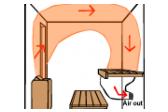
Proper ventilation in your sauna ensure that you’re breathing fresh air, and help circulate heat around the room.

Since most steam baths and saunas (excluding FIR saunas) rely on trapped heat to warm you, they work best when almost completely sealed. There must be some ventilation though – without it, the sauna would quickly become unbearably stale and stuffy. Likewise, without proper ventilation moisture and humidity won’t be allowed to escape when the sauna’s not in use. This can lead to mould, rot and general deterioration. To allow air to circulate, saunas require a ventilation shaft to allow air in and an exhaust fan to move air out.
Vents in saunas
Putting an inlet vent in a sauna can be as easy as leaving a 2-3cm gap between the bottom of the door and the floor, but most vents are located near the base of the heater to allow for the best possible circulation of hot air. The exhaust fan is normally positioned on the opposite wall, close to the ceiling. The cold air is drawn in from underneath the heater, and brought up in front of the heater to be warmed. The hotter stale air rises to the top, to be skimmed off by the exhaust fan.
It’s important to be able to adjust the speed of your fan, as this can play a crucial part in maintaining your sauna temperature. If the fan is moving too much air, the sauna won’t be hot enough. If it’s not strong enough, air won’t circulate properly and the sauna will become stifling.





